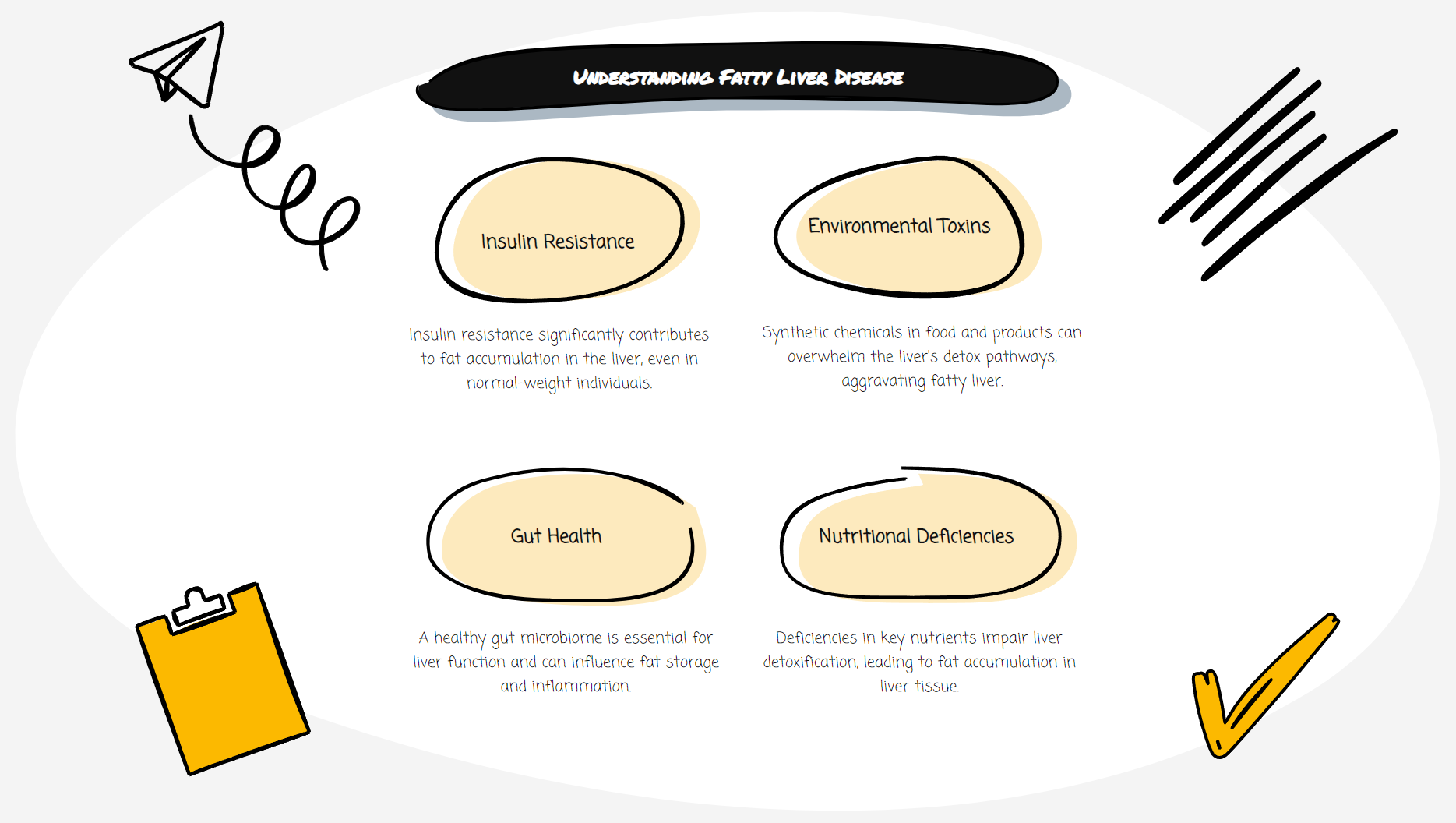
Fatty Liver Disease Is More Than Just Alcohol and Obesity
Fatty Liver Disease Is More Than Just Alcohol and Obesity
Millions walk around unaware. Their livers slowly accumulate fat, inflammation builds, and cellular damage progresses silently. By the time symptoms appear, the disease has often advanced considerably.
Non-alcoholic fatty liver disease affects roughly 25% of adults worldwide, yet conventional medicine still primarily focuses on weight loss and avoiding alcohol. While these recommendations have merit, they represent an incomplete approach to a complex metabolic problem.
The liver is our primary detoxification organ, processing everything from medications to environmental toxins. When it becomes compromised, the entire body suffers. Understanding the root causes of fatty liver requires looking beyond simplistic explanations and exploring the interconnected systems that influence liver health.
The Limitations of Conventional Approaches
Standard medical care for fatty liver typically involves recommendations to lose weight, exercise more, and reduce alcohol consumption. Medications to control blood sugar or cholesterol might be prescribed for those with more advanced disease. These interventions address symptoms rather than underlying causes.
Blood tests often miss early-stage fatty liver, and by the time liver enzymes become elevated, significant damage may have occurred. Ultrasounds and other imaging techniques can identify fat accumulation but provide little insight into why it's happening.
This reactive approach fails many patients. A deeper understanding requires examining the metabolic, environmental, and nutritional factors contributing to liver dysfunction.
Root Causes Beyond the Obvious
Insulin resistance is perhaps the most significant yet underappreciated cause of fatty liver disease. When cells become resistant to insulin, the liver compensates by converting excess glucose to fat, which accumulates in the liver tissue. This process occurs even in individuals with normal body weight.
Environmental toxins represent another critical factor. The liver must process thousands of synthetic chemicals in food, water, personal care products, and our environment. This toxic burden can overwhelm detoxification pathways and contribute to fat accumulation and inflammation.
Gut health plays a crucial role, too. Disruptions in the intestinal barrier can allow bacterial endotoxins to enter the portal circulation and reach the liver, triggering inflammatory responses. The gut microbiome also influences metabolism, hormone regulation, and immune function, all impacting liver health.
Nutritional deficiencies further complicate the picture. The liver requires specific nutrients to perform its detoxification functions efficiently. Deficiencies in choline, methionine, glutathione precursors, and various B vitamins can impair these processes and contribute to fat accumulation.
Chronic stress deserves attention as well. Stress hormones alter metabolism and can promote fat storage. They also influence inflammatory pathways and immune function, potentially exacerbating liver damage.
Natural Solutions With Scientific Support
Addressing fatty liver naturally requires a comprehensive approach that targets these root causes. Several evidence-based strategies show promise beyond conventional recommendations.
Nutritional interventions should focus on reducing insulin resistance. This means eliminating refined carbohydrates and sugars while emphasizing whole foods rich in fiber, protein, and healthy fats. Intermittent fasting protocols have shown remarkable benefits for liver health by improving insulin sensitivity and promoting cellular repair mechanisms.
Specific nutrients deserve special attention. Choline, found in eggs, liver, and cruciferous vegetables, plays a crucial role in fat transport out of the liver. Milk thistle (silymarin) has demonstrated hepatoprotective effects in multiple studies. N-acetyl cysteine supports glutathione production, enhancing the liver's detoxification capacity.
Gut healing protocols can reduce the inflammatory burden on the liver. This includes removing food sensitivities, incorporating fermented foods, and sometimes using targeted probiotics to restore microbial balance.
Regular movement stimulates circulation through the liver and improves insulin sensitivity. However, excessively high-intensity exercise can sometimes increase oxidative stress, so balanced approaches work best for those with existing liver issues.
Environmental detoxification strategies reduce the burden on the liver. This includes filtering drinking water, choosing organic foods when possible, and minimizing exposure to household chemicals and plastics.
Integration Rather Than Opposition
The most effective approach to fatty liver disease integrates the best of conventional and natural medicine. Regular monitoring through appropriate medical testing provides objective markers of progress. Medications may be necessary in advanced cases, while natural interventions address underlying causes.
This integrated approach recognizes that the human body functions as an interconnected system. The liver is not isolated from hormones, gut function, or environmental influences. Treating it as if it does leads to incomplete solutions.
The future of fatty liver treatment lies in personalized protocols that address individual metabolic patterns, genetic predispositions, and environmental exposures. This requires moving beyond one-size-fits-all recommendations and generic dietary guidelines.
A Path Forward
Fatty liver disease is a warning sign from the body that metabolic processes have become dysregulated. Rather than simply managing this condition, we can use it as motivation to restore balance to our most important detoxification organ.
By addressing insulin resistance, supporting detoxification pathways, healing the gut, providing essential nutrients, and reducing toxic exposures, we create the conditions for the liver to recover. When given the right tools, the body possesses remarkable regenerative capacity.
The most profound healing occurs when we view health challenges through a lens encompassing all influencing factors. Fatty liver disease is a perfect example of how this comprehensive approach can succeed where narrower perspectives fail.
As our understanding of the complex interplay between genetics, environment, and lifestyle deepens, so will our ability to address fatty liver disease at its roots. The solution lies not in choosing between conventional and natural approaches, but in thoughtfully integrating them to support the body's innate healing mechanisms.
